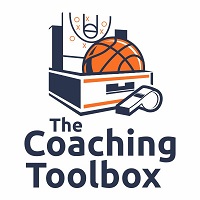
This article was posted with the permission of retired NBA Coach Del Harris
Regarding pick and roll defenses:
- Avoid “stringing out” too far on showing/hedging from the picker.
It is fine to jump up hard in a position parallel, or virtually so, to the sideline and go a step or even two with the ballhandler as a defensive option.
Continuing to string out with the ball handler forces the team defense has to rotate to your man on any kind of show.
The stringer is in a position too far out to rotate back safely to any man.
Remedy: After a defender shows, he needs to recover quickly “down the line” toward the free throw lane, not out toward the sideline.
- When defending elbow area picks, show hard or at the angle to corner but:
If you show hard, your man will roll to the basket and will have to be picked up by a teammate.
Show high, stay high. The defender on the elbow who shows aggressively must be prepared to cover the pop by the picker or, if he rolls, to cover the next player who comes up high—“show high, stay high!”
If you show at a 45 degree angle, then you cannot string out toward the corner more than a step.
Show “down the line” so as to be able to stay in a position whereby you are able to slow down the ball and still make it hard to pass to the roller by staying in the pass lane with active hands.
Weak side help is vital. As in showing at an angle anywhere (covering the turn) on the pick and rolls, the defender goes down the line but still needs help.
- To turn the pick/roll down? If you try to mix your pick and roll defenses by “turning it down” here are some suggestions:
First, do not be afraid to try it. But then do not be like many NBA teams and overdo it. It is a good change up, when done right, and a lot of teams do not do a good job of going against it. (But that is changing in the NBA now as teams overuse it.)
The defender on the picker must call it out loud and clear three times, (whatever signal you decide to use) and the ball defender cannot change positions until he hears it, no matter what the game plan is.
The picker defender must get into a strong, athletic position ready to defend any attacker and stay in it. This is crucial.
The picker defender must get into a line between the ball and the basket but ought not to be any further from the picker than an arm’s length plus a step, certainly no more than two steps.
The biggest concerns are:
- The ballhandler splitting between him and the picker, leaving the ball defender behind,
- And allowing a quick short bounce pass (“pocket pass”) to the picker whereby he can catch and get to the goal or catch/shoot so quickly no one can get to him.
If the ball is penetrated the picker’s defender will try to defend both players as long as he can, by dropping down the line toward the goal.
The ball defender must try to recover back in front, but the help defender must be ready to commit to the ball if he has to (trap or late switch).
The defender on the ball must quickly jump to the high side of the ballhandler, maintaining at least a touch with his man, and be in a position to force him to go to the sideline/baseline instead of penetrating to the middle.
Do not get too high on the top of the ballhandler. Be only slightly higher than parallel with the sideline, not turned too far toward the baseline because it encourages a split.
Note: if you are a zone team. Turn all the pick and rolls on the wing or corner areas down. Usually players can switch the top and elbow pick and rolls.






